In any research study, there are variables. Variables are any characteristics that can be measured or observed. There are many great uses for these variables, but it is important to know what they are!
Understanding the difference between different types of variables is key to more research.
In this article, you will learn the basics of variables and will give you a clear picture of the types of variables that exist in the social sciences and statistics and how they can be used.
Find out what the types of variables are, how they are measured, and how to choose one for your research project.
What is a Variable?
In statistics and research, variables are items that you can measure, modify, and control. Every study looks at a variable, which can be a person, location, thing, or idea. The value of a variable can change between groups or over time.
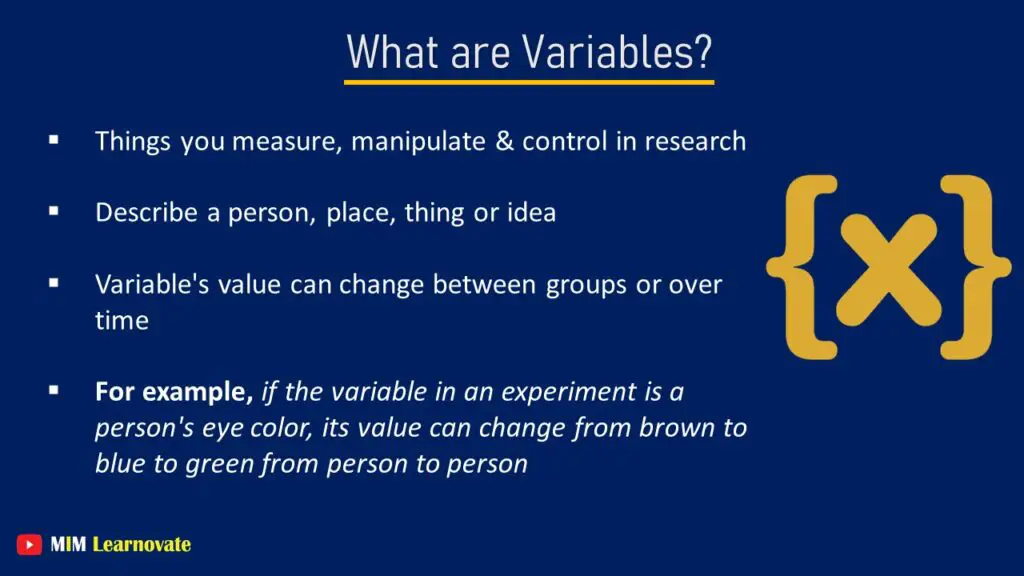
In research, variables are the factors that are manipulated to measure their effects on an outcome variable.
- A variable is any characteristic of an individual, group, organization or social phenomenon that changes.
- A variable is something which varies and can have more than one value.
- A Variable is attribute or characteristic of an entity.
Example of Variable
1- Suppose lets take organization as an example. Organization is an entity. Name, Size, Type, Learning, Innovation are the attributes of an organization. So all these attributes are the variables.
2- Other example is that Employee is also an entity. Name, Age, Gender, Experience, Stress level, satisfaction, Performance are the attributes of an employee. So all these attributes are the variables.

3- For example, if a person’s skin color is the variable in an experiment, its value can range from brown to pale to white, from individual to individual.
Read More:
- Operationalization of Variables Examples | Benefits, Drawbacks | Table
- Measurement of Scale | Examples | PPT
- Types of Validity in Research | Examples | PPT
- Types of Reliability in Research | Example | PPT
- Quasi-Experimental Design Example, Types | PPT
- Mixed Method Research: What It Is & Why You Should Use It
10 Types of Variables
Researchers classify variables into several categories, the most popular of which are,
- Independent variable
- Dependent variable
- Moderating variable
- Mediating variable
- Control variable
- Qualitative variable
- Quantitative variable
- Extraneous variable
- Composite variable
- Confounding variable
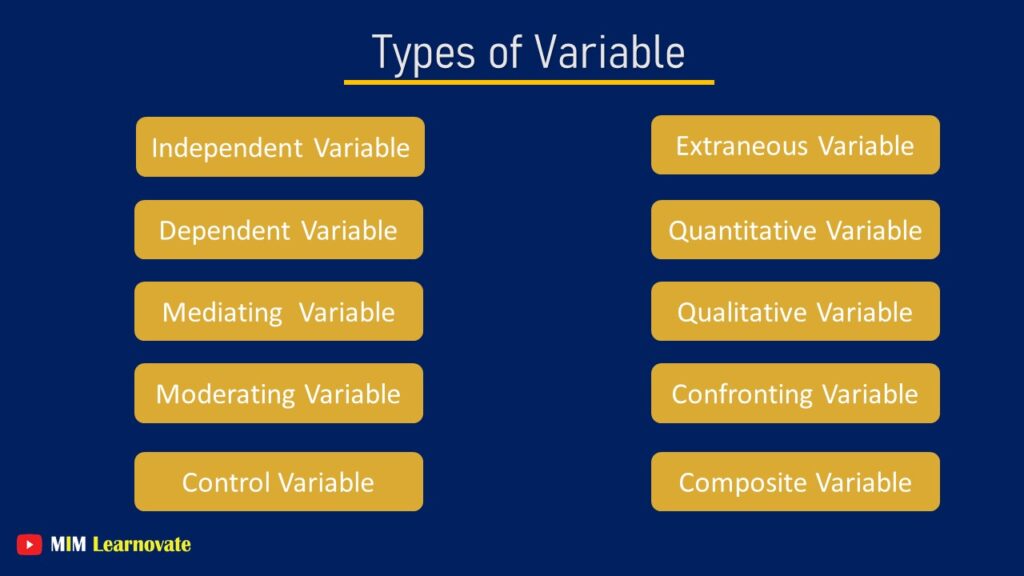
Independent Variable
The variable that is manipulated to measure its effects on an outcome variable. Independent variables are the variable that is being manipulated by the researcher.

- The independent variable is the factor that the researcher purposely change or control in order to see what effect it has.
- The variable which causes affect on dependent variable.
- It is also called predictor or explanatory variable.
Example of Independent Variable
The amount of sugar, added to each cup of orange juice.
Dependent Variable
The dependent variable is a variable that represents the experiment’s outcome. The variable that is measured in order to determine the effect of an independent variable. The dependent variable is the variable being measured.
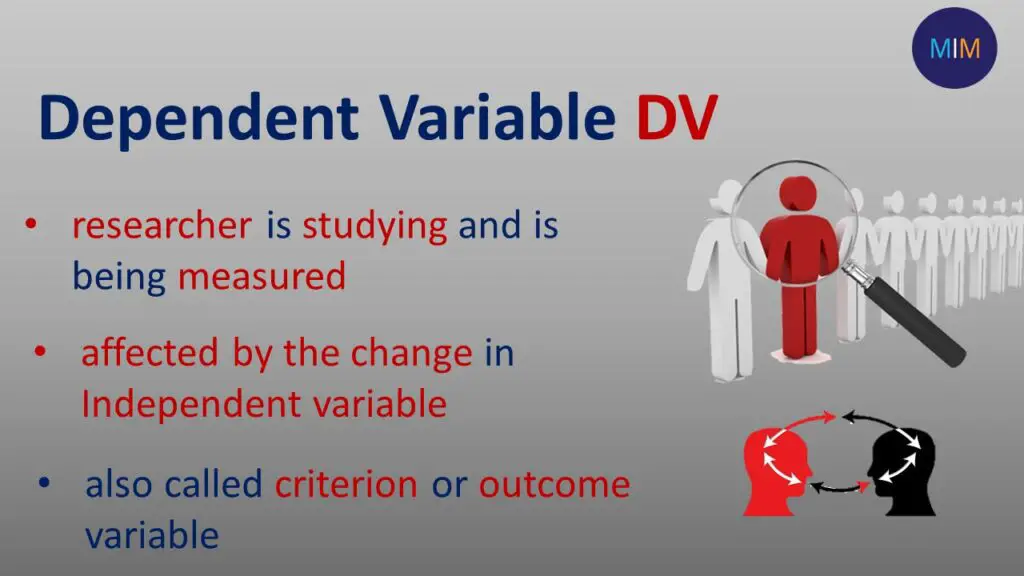
- It is the variable which the researcher is studying and is being measured.
- It is affected by the change in Independent variable.
- It is also called criterion or outcome variable.
Example of Dependent Variable
Any measurement, of human health, and growth.

Mediating Variable
A mediating variable is a theoretical variable used by a researcher to explain a reason or relationship between other study factors, typically dependent and independent variables. Mediating variables are those that exist between the independent and dependent variable and could potentially affect the relationship between them.

- It is the variable that is between independent variable and dependent variable.
- It explains the relationship between Independent Variable and Dependent Variable.
- It is also called intervening variable.
Example of Mediating Variable
For example, if income is the independent variable and longevity is the dependent variable, the researcher could postulate that access to quality healthcare is the mediating variable that connects income and longevity.
Moderating Variable
A moderating variable, also known as a moderator variable, modifies the link between dependent and independent factors by strengthening or diminishing the effect of the mediating variable.
Moderating variables are those that moderate or change the relationship between the independent and dependent variable.
- It is the variable that effects the relationship between independent variable and dependent variable.
- This variable either weaken or strengthen the relationship of IV and DV.
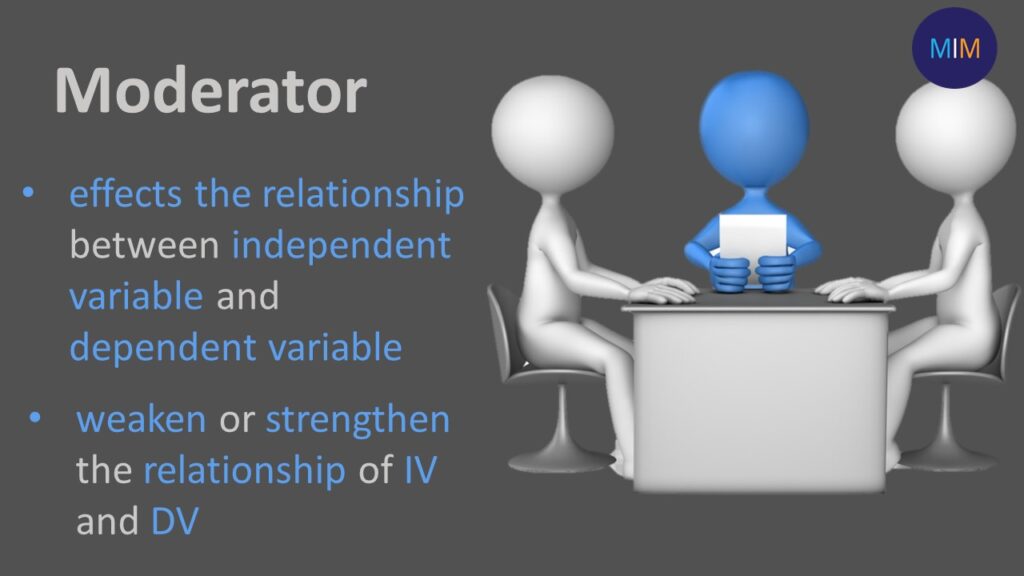
Example of Mediating Variable
While social media use can predict isolation, this association may be higher in teens than in older persons. Age is a moderator here.
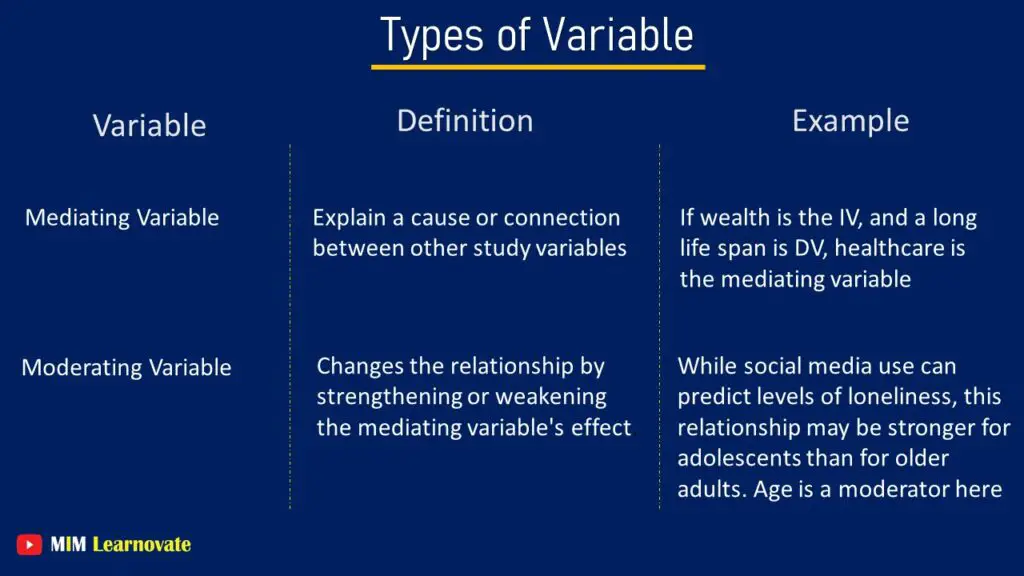
Control Variables
Control variables are those that remain constant throughout the experiment. Variables that are held constant in order to isolate the effect of a given independent variable.
- A control variable strongly influences values
- It is held constant to test the relative impact of independent variables.
- It is also called constant variable
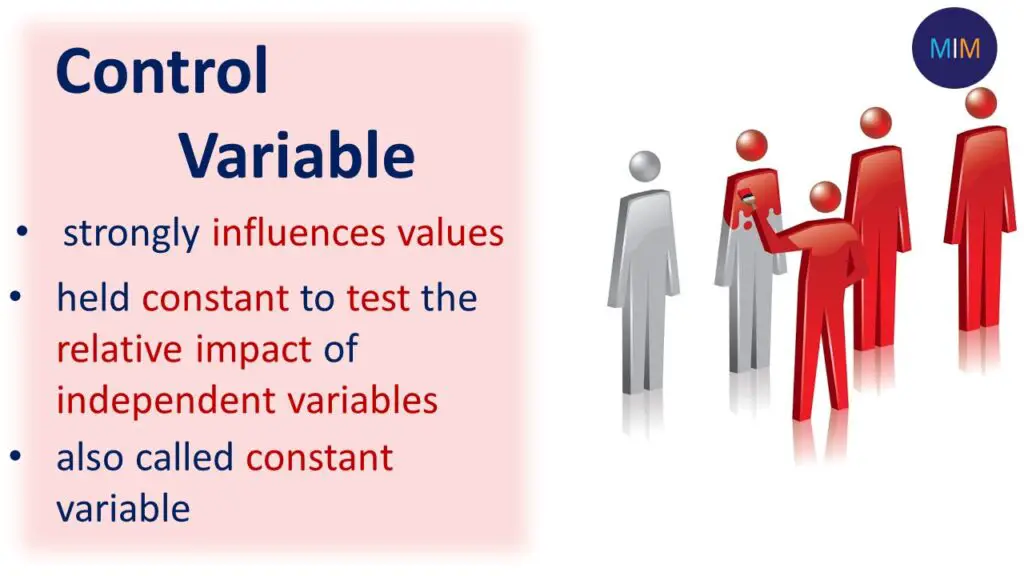
Example of Control Variables
The temperature, and light, in the room the plants are kept in, and the volume of water, given to each plant.
Developing Conceptual Framework with variables
Now I am going to give example to explain further. Suppose, Organizational learning has an impact on innovation. Organizational learning and innovation are variables.
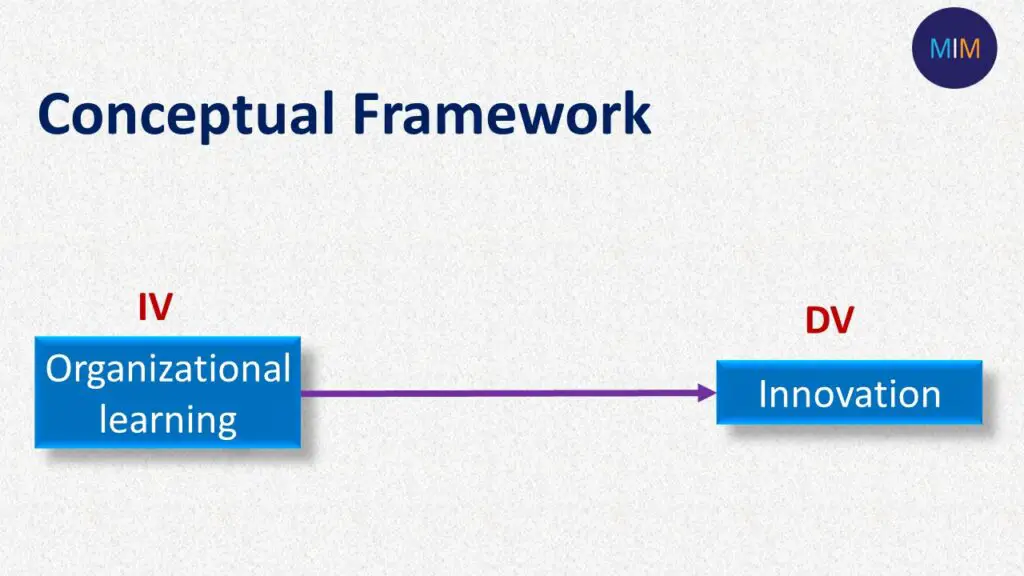
Organization learning is IV that is independent variable and innovation is DV dependent Variable.
Organizational learning enhances that impact of innovation in the firm. So there is positive relation between two variables. Note that DV is always on the right side whereas IV is on the left side
Lets take creativity as a mediator because organizational learning brings creativity which will help employees to be more innovative. So creativity is explaining the relationship between organizational learning and innovation and creativity helps to achieve innovation.
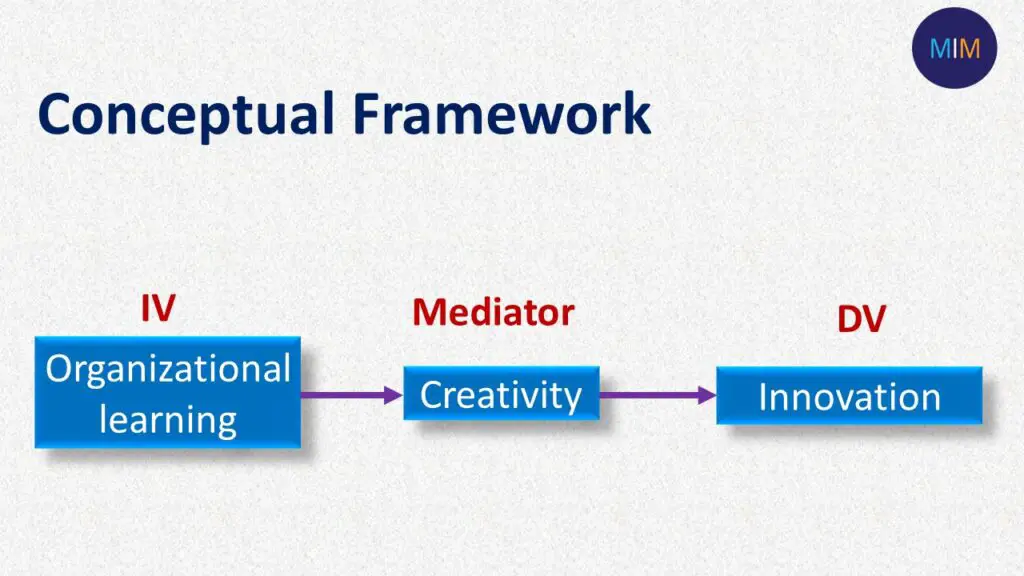
Lets add moderator between organizational learning and innovation. Take leadership as a moderator as it will strengthen the relationship of IV and DV.
Leadership influences employees to produce creative ideas, products, and services hence bringing innovation in the firm.
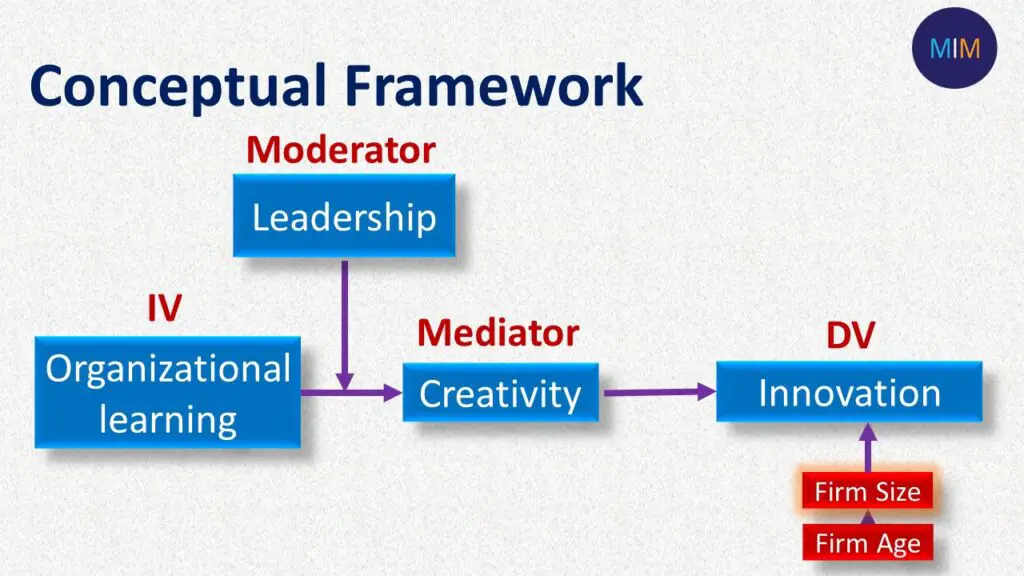
These three variables organizational learning, leadership , creativity effects innovation but there could be other variables that affects innovation like firm size and firm age.
The larger firms need to be more innovative as compared to the smaller firms. So, these variables, by default have impact on firm’s innovation. So, we should control these variables in order to see whether IV, mediator and moderator have an effect on the dependent variable.
Quantitative Variable
A quantitative variable is any data set that contains numbers or amounts. There are two kinds of quantitative variables:
- Discrete variables
- Continuous variables
Example of Quantitative Variable
Quantity of things like weigh, Height, distance
Discrete Variable
Any numerical variables, you can realistically count. Discrete variables are those that can only take on a limited number of values. In research, discrete variables are often used to represent categorical data, such as gender or race. Discrete variables are often represented by integers.
Example of Discrete Variable
1- As an example, consider the money in your pocket or the funds in your savings account.
Continuous Variable
A continuous variable is a variable that can take on any value within a certain range. In research, a continuous variable is often used to measure things like opinion or behavior.
- Continuous variables are important because they allow researchers to get more detailed information about a population.
- Continuous variables are also useful for measuring change over time.
Example of Continuous Variable
1- If researchers want to know how people feel about a new product, they can use a continuous variable to measure how much people like the product on a scale of 1 to 10.
2- If researchers want to know whether people’s opinions about a product are changing, they can use a continuous variable to measure how people’s opinions change from month to month.
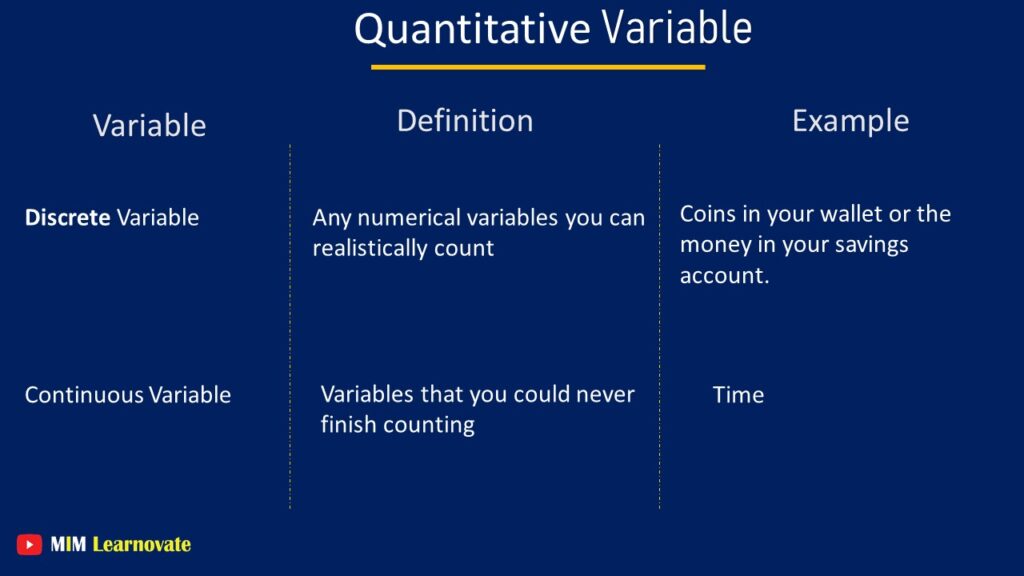
Qualitative Variables
Qualitative variables, often known as categorical variables, are non-numerical values or categories. You can realistically count any numerical variables.
Example of Qualitative Variables
Eye color, skin color or hair color.
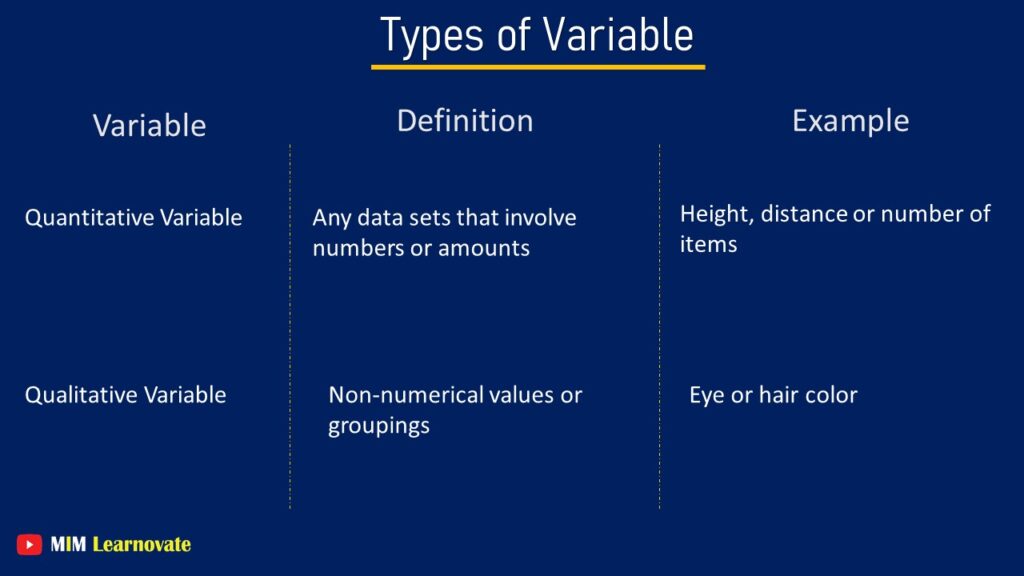
There are three kinds of qualitative variables.
- Binary variable
- Nominal variable
- Ordinal variable
Binary Variable
A binary variable is a variable that can take on only two values, usually 0 and 1. In research, binary variables are often used to represent the presence or absence of something,
Binary variables can be either categorical or numerical. Categorical binary variables are also called dichotomous variables. A numerical binary variable is one where the two values represent different levels of a quantitative variable, such as small and large.
Binary variables are often used in logistic regression, which is a type of statistical analysis that is used to predict the probability of an event occurring.
Example of Binary Variable
1- To know whether a person has a disease (0 = no, 1 = yes).
2- Male or female, black or white.
Nominal Variable
A nominal variable is a type of variable that is used to label or categorize data. Nominal variables are often used in research to create groups or categories for analysis. There is no rank or order between these groups. e.g. Species names and brand names.
Nominal variables are sometimes called categorical variables. Nominal variables are usually coded with numbers, but the numbers do not have any mathematical meaning. In other words, the order of the numbers does not matter.
Example of Binary Variable
1- If you were coding gender with the numbers 1 and 2, it would not matter if you coded 1 as male and 2 as female, or vice versa.
2- A researcher may use a nominal variable to group participants by gender, age, or race.
Ordinal Variable
In research, an ordinal variable is a variable that is used to rank items. They are the groups that are arranged in a particular order. Ordinal variables are often used in surveys.
Example of Ordinal Variable
1- A survey might ask respondents to rate their satisfaction with a product on a scale of 1 to 5, with 1 being very dissatisfied and 5 being very satisfied. In this case, the responses would be an ordinal variable.
2. If you were researching the most popular books among teenagers, you would use an ordinal variable to rank the books from most popular to least popular.
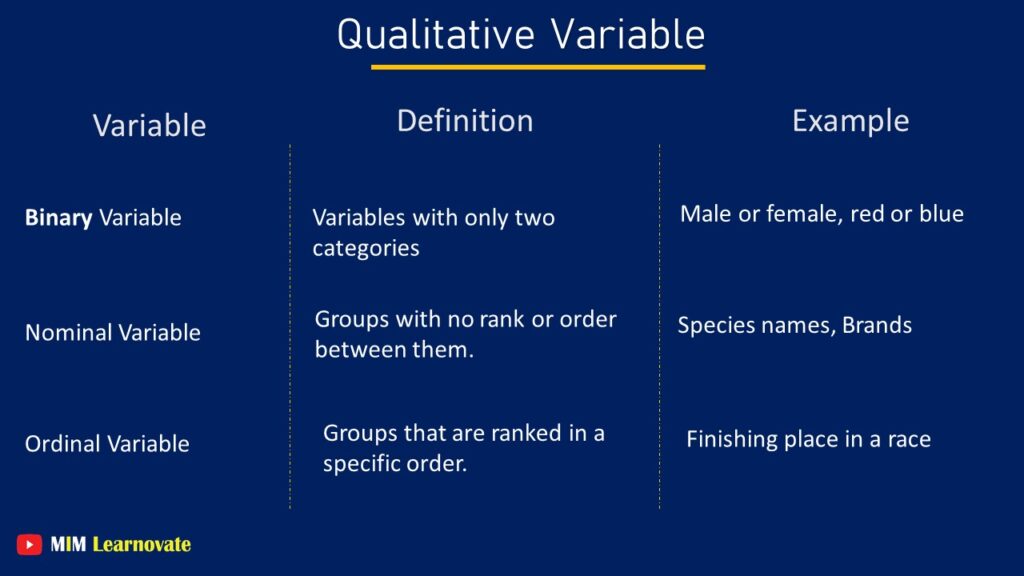
Extraneous Variable
Extraneous variables are factors that affect the dependent variable but were not originally considered by the researcher while designing the experiment. These unexpected variables can alter the outcomes of a study or how a researcher perceives the results.
An extraneous variable is a variable that is not related to the main independent or dependent variables in a study. This can be a problem because it can skew the results of the study, making it difficult to interpret. There are ways to control for extraneous variables, however, by using experimental design and/or statistical methods.
Example of Extraneous Variable
A study could be conducted to determine if private tutoring or online courses are more helpful at improving students’ Spanish test scores. Parental support, prior understanding of a foreign language, or socioeconomic background are examples of extraneous elements that may unintentionally influence the outcome.
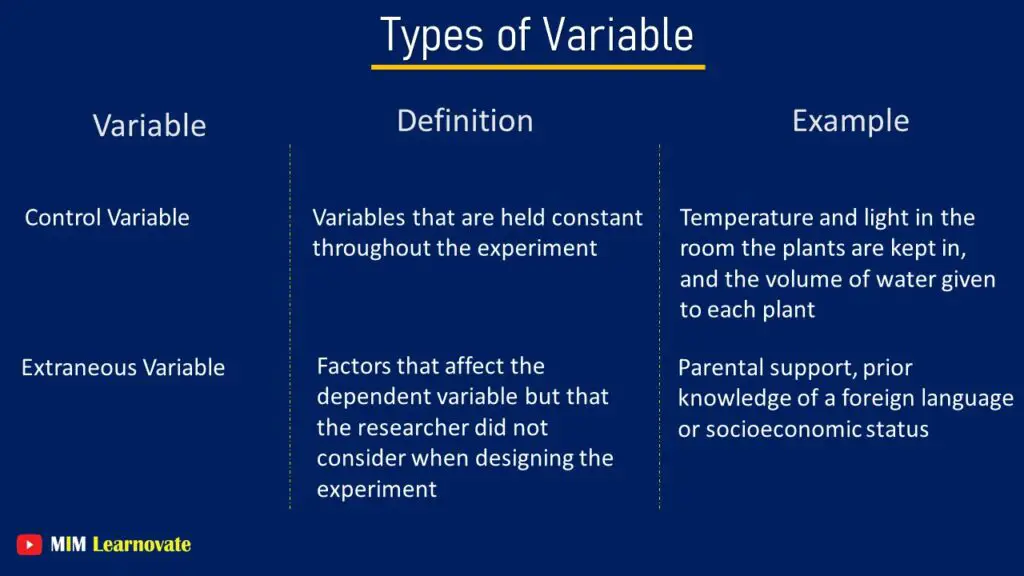
Latent Variable
A latent variable is a variable that is not directly observed but is instead inferred from other variables that are observed.
- used in statistical models to explain the relationships between observed variables.
- useful for understanding the relationships between different factors in a complex system.
- help to explain why some people are more successful than others.
Example of Latent Variable
1- In a study of the relationship between IQ and success, latent variables could be used to represent factors such as motivation and opportunity.
2- in a study of the relationship between job satisfaction and job performance, latent variables could be used to represent factors such as motivation and ability.
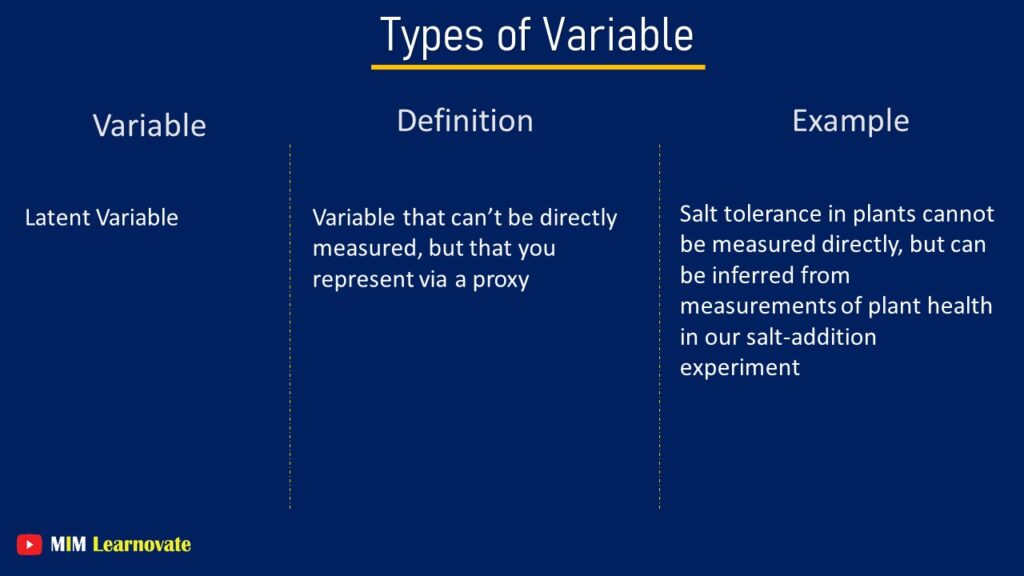
Confounding Variable
A variable in your experiment that conceals the true influence of another variable. This can occur when another variable is strongly related to a variable of interest but is not controlled in your experiment.
A confounding variable is an extraneous variable in a statistical model that correlates with both the dependent and independent variables. This confounds the interpretation of the results because it is not possible to tell which variables are causing the relationship. The most common way to control for confounding variables is to include them in the model as covariates.
Confounding variables are a problem in observational studies because they can lead to biased estimates of the exposure-outcome association. It is important to be aware of potential confounding variables when interpreting results from observational studies.
Example of Confounding Variable
1- Suppose there is an association between smoking and lung cancer. If age is a confounder, then this means that older people are more likely to get lung cancer, but they are also more likely to smoke. Therefore, the true association between smoking and lung cancer may be underestimated if age is not taken into account.
2- Pot size and soil type, for example, may affect plant longevity as much as or more than salt doses. These potential confounders would be controlled in an experiment by holding them constant.
Composite Variable
Composite variables are those that are created by combining two or more other variables. They can be useful because they can provide a more accurate representation of what you’re trying to measure.
Example of Composite Variable
A composite variable could be created by combining the variables “height” and “weight” to create the variable “BMI.”
The variable “BMI” is a better measure of body fat than either “height” or “weight” alone.
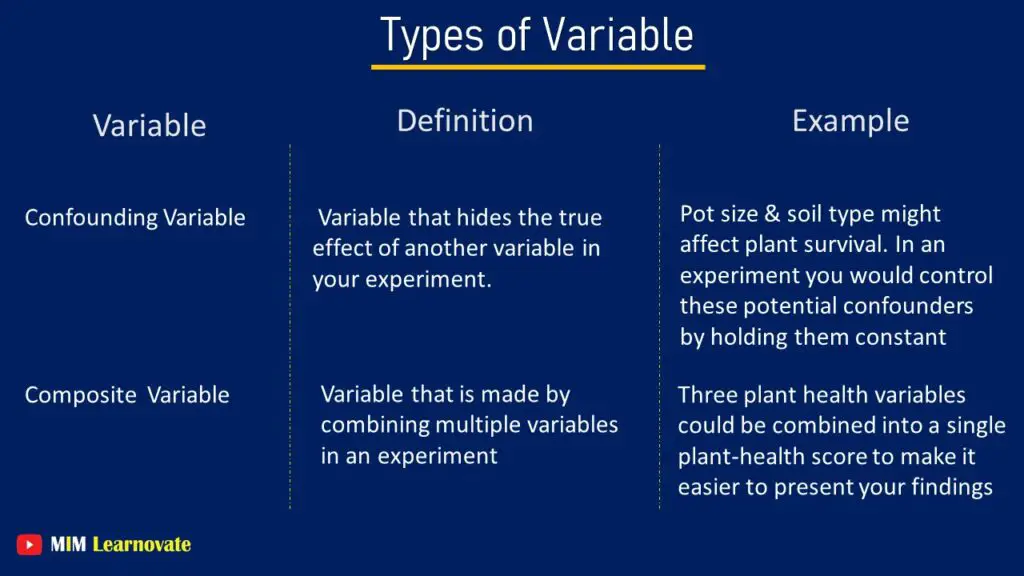
Other articles
Please read through some of our other articles with examples and explanations if you’d like to learn more about research methodology.
Statistics
Methodology
- Research Methods
- Quantitative Research
- Qualitative Research
- Case Study Research
- Survey Research
- Conclusive Research
- Descriptive Research
- Cross-Sectional Research
- Theoretical Framework
- Conceptual Framework
- Triangulation
- Grounded Theory
- Quasi-Experimental Design
- Mixed Method
- Correlational Research
- Randomized Controlled Trial
- Stratified Sampling
- Ethnography
- Ghost Authorship
- Secondary Data Collection
- Primary Data Collection
- Ex-Post-Facto
Research
- Table of Contents
- Dissertation Topic
- Synopsis
- Thesis Statement
- Research Proposal
- Research Questions
- Research Problem
- Research Gap
- Types of Research Gaps
- Variables
- Operationalization of Variables
- Literature Review
- Research Hypothesis
- Questionnaire
- Abstract
- Validity
- Reliability
- Measurement of Scale
- Sampling Techniques
- Acknowledgements


